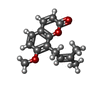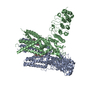+ Open data
Open data
- Basic information
Basic information
| Entry | Database: EMDB / ID: EMD-24385 | ||||||||||||||||||
|---|---|---|---|---|---|---|---|---|---|---|---|---|---|---|---|---|---|---|---|
| Title | Structure of TRPV3 in complex with osthole | ||||||||||||||||||
 Map data Map data | TRPV3 in complex with osthole | ||||||||||||||||||
 Sample Sample |
| ||||||||||||||||||
| Function / homology |  Function and homology information Function and homology informationnegative regulation of hair cycle /  TRP channels / response to temperature stimulus / positive regulation of calcium ion import / monoatomic cation channel activity / TRP channels / response to temperature stimulus / positive regulation of calcium ion import / monoatomic cation channel activity /  calcium channel activity / monoatomic ion channel activity / calcium channel activity / monoatomic ion channel activity /  receptor complex / receptor complex /  membrane / identical protein binding membrane / identical protein bindingSimilarity search - Function | ||||||||||||||||||
| Biological species |   Mus musculus (house mouse) Mus musculus (house mouse) | ||||||||||||||||||
| Method |  single particle reconstruction / single particle reconstruction /  cryo EM / Resolution: 3.64 Å cryo EM / Resolution: 3.64 Å | ||||||||||||||||||
 Authors Authors | Neuberger A / Nadezhdin KD / Sobolevsky AI | ||||||||||||||||||
| Funding support |  United States, United States,  Germany, 5 items Germany, 5 items
| ||||||||||||||||||
 Citation Citation |  Journal: EMBO Rep / Year: 2021 Journal: EMBO Rep / Year: 2021Title: Structural mechanism of TRPV3 channel inhibition by the plant-derived coumarin osthole. Authors: Arthur Neuberger / Kirill D Nadezhdin / Eleonora Zakharian / Alexander I Sobolevsky /  Abstract: TRPV3, a representative of the vanilloid subfamily of TRP channels, is predominantly expressed in skin keratinocytes and has been implicated in cutaneous sensation and associated with numerous skin ...TRPV3, a representative of the vanilloid subfamily of TRP channels, is predominantly expressed in skin keratinocytes and has been implicated in cutaneous sensation and associated with numerous skin pathologies and cancers. TRPV3 is inhibited by the natural coumarin derivative osthole, an active ingredient of Cnidium monnieri, which has been used in traditional Chinese medicine for the treatment of a variety of human diseases. However, the structural basis of channel inhibition by osthole has remained elusive. Here we present cryo-EM structures of TRPV3 in complex with osthole, revealing two types of osthole binding sites in the transmembrane region of TRPV3 that coincide with the binding sites of agonist 2-APB. Osthole binding converts the channel pore into a previously unidentified conformation with a widely open selectivity filter and closed intracellular gate. Our structures provide insight into competitive inhibition of TRPV3 by osthole and can serve as a template for the design of osthole chemistry-inspired drugs targeting TRPV3-associated diseases. | ||||||||||||||||||
| History |
|
- Structure visualization
Structure visualization
| Movie |
 Movie viewer Movie viewer |
|---|---|
| Structure viewer | EM map:  SurfView SurfView Molmil Molmil Jmol/JSmol Jmol/JSmol |
| Supplemental images |
- Downloads & links
Downloads & links
-EMDB archive
| Map data |  emd_24385.map.gz emd_24385.map.gz | 85.5 MB |  EMDB map data format EMDB map data format | |
|---|---|---|---|---|
| Header (meta data) |  emd-24385-v30.xml emd-24385-v30.xml emd-24385.xml emd-24385.xml | 15.3 KB 15.3 KB | Display Display |  EMDB header EMDB header |
| Images |  emd_24385.png emd_24385.png | 56.1 KB | ||
| Archive directory |  http://ftp.pdbj.org/pub/emdb/structures/EMD-24385 http://ftp.pdbj.org/pub/emdb/structures/EMD-24385 ftp://ftp.pdbj.org/pub/emdb/structures/EMD-24385 ftp://ftp.pdbj.org/pub/emdb/structures/EMD-24385 | HTTPS FTP |
-Related structure data
| Related structure data |  7rasMC  7rauC M: atomic model generated by this map C: citing same article ( |
|---|---|
| Similar structure data |
- Links
Links
| EMDB pages |  EMDB (EBI/PDBe) / EMDB (EBI/PDBe) /  EMDataResource EMDataResource |
|---|---|
| Related items in Molecule of the Month |
- Map
Map
| File |  Download / File: emd_24385.map.gz / Format: CCP4 / Size: 91.1 MB / Type: IMAGE STORED AS FLOATING POINT NUMBER (4 BYTES) Download / File: emd_24385.map.gz / Format: CCP4 / Size: 91.1 MB / Type: IMAGE STORED AS FLOATING POINT NUMBER (4 BYTES) | ||||||||||||||||||||||||||||||||||||||||||||||||||||||||||||||||||||
|---|---|---|---|---|---|---|---|---|---|---|---|---|---|---|---|---|---|---|---|---|---|---|---|---|---|---|---|---|---|---|---|---|---|---|---|---|---|---|---|---|---|---|---|---|---|---|---|---|---|---|---|---|---|---|---|---|---|---|---|---|---|---|---|---|---|---|---|---|---|
| Annotation | TRPV3 in complex with osthole | ||||||||||||||||||||||||||||||||||||||||||||||||||||||||||||||||||||
| Voxel size | X=Y=Z: 0.83 Å | ||||||||||||||||||||||||||||||||||||||||||||||||||||||||||||||||||||
| Density |
| ||||||||||||||||||||||||||||||||||||||||||||||||||||||||||||||||||||
| Symmetry | Space group: 1 | ||||||||||||||||||||||||||||||||||||||||||||||||||||||||||||||||||||
| Details | EMDB XML:
CCP4 map header:
| ||||||||||||||||||||||||||||||||||||||||||||||||||||||||||||||||||||
-Supplemental data
- Sample components
Sample components
-Entire : sample 1
| Entire | Name: sample 1 |
|---|---|
| Components |
|
-Supramolecule #1: sample 1
| Supramolecule | Name: sample 1 / type: complex / ID: 1 / Parent: 0 / Macromolecule list: #1 |
|---|---|
| Source (natural) | Organism:   Mus musculus (house mouse) Mus musculus (house mouse) |
| Recombinant expression | Organism:   Homo sapiens (human) Homo sapiens (human) |
-Macromolecule #1: Transient receptor potential cation channel subfamily V member 3
| Macromolecule | Name: Transient receptor potential cation channel subfamily V member 3 type: protein_or_peptide / ID: 1 / Number of copies: 4 / Enantiomer: LEVO |
|---|---|
| Source (natural) | Organism:   Mus musculus (house mouse) Mus musculus (house mouse) |
| Molecular weight | Theoretical: 92.481547 KDa |
| Recombinant expression | Organism:   Homo sapiens (human) Homo sapiens (human) |
| Sequence | String: MGAHSKEMAP LMGKRTTAPG GNPVVLTEKR PADLTPTKKS AHFFLEIEGF EPNPTVTKTS PPIFSKPMDS NIRQCLSGNC DDMDSPQSP QDDVTETPSN PNSPSANLAK EEQRQKKKRL KKRIFAAVSE GCVEELRELL QDLQDLCRRR RGLDVPDFLM H KLTASDTG ...String: MGAHSKEMAP LMGKRTTAPG GNPVVLTEKR PADLTPTKKS AHFFLEIEGF EPNPTVTKTS PPIFSKPMDS NIRQCLSGNC DDMDSPQSP QDDVTETPSN PNSPSANLAK EEQRQKKKRL KKRIFAAVSE GCVEELRELL QDLQDLCRRR RGLDVPDFLM H KLTASDTG KTCLMKALLN INPNTKEIVR ILLAFAEEND ILDRFINAEY TEEAYEGQTA LNIAIERRQG DITAVLIAAG AD VNAHAKG VFFNPKYQHE GFYFGETPLA LAACTNQPEI VQLLMENEQT DITSQDSRGN NILHALVTVA EDFKTQNDFV KRM YDMILL RSGNWELETM RNNDGLTPLQ LAAKMGKAEI LKYILSREIK EKPLRSLSRK FTDWAYGPVS SSLYDLTNVD TTTD NSVLE IIVYNTNIDN RHEMLTLEPL HTLLHTKWKK FAKYMFFLSF CFYFFYNITL TLVSYYRPRE DEDLPHPLAL THKMS WLQL LGRMFVLIWA TCISVKEGIA IFLLRPSDLQ SILSDAWFHF VFFVQAVLVI LSVFLYLFAY KEYLACLVLA MALGWA NML AYTRGFQSMG MYSVMIQKVI LHDVLKFLFV YILFLLGFGV ALASLIEKCS KDKKDCSSYG SFSDAVLELF KLTIGLG DL NIQQNSTYPI LFLFLLITYV ILTFVLLLNM LIALMGETVE NVSKESERIW RLQRARTILE FEKMLPEWLR SRFRMGEL C KVADEDFRLC LRINEVKWTE WKTHVSFLNE DPGPIRRTAD LNKIQDSSRS NSKTTLYAFD ELDEFPETSV LVPRGSAAA WSHPQFEK |
-Macromolecule #2: 7-methoxy-8-(3-methylbut-2-enyl)chromen-2-one
| Macromolecule | Name: 7-methoxy-8-(3-methylbut-2-enyl)chromen-2-one / type: ligand / ID: 2 / Number of copies: 8 / Formula: A0O |
|---|---|
| Molecular weight | Theoretical: 244.286 Da |
| Chemical component information |  ChemComp-A0O: |
-Experimental details
-Structure determination
| Method |  cryo EM cryo EM |
|---|---|
 Processing Processing |  single particle reconstruction single particle reconstruction |
| Aggregation state | particle |
- Sample preparation
Sample preparation
| Concentration | 3 mg/mL | ||||||||||||||||||
|---|---|---|---|---|---|---|---|---|---|---|---|---|---|---|---|---|---|---|---|
| Buffer | pH: 8 Component:
| ||||||||||||||||||
| Grid | Model: C-flat-1.2/1.3 / Material: GOLD / Mesh: 200 / Support film - Material: GOLD / Support film - topology: HOLEY | ||||||||||||||||||
| Vitrification | Cryogen name: ETHANE / Chamber humidity: 100 % / Chamber temperature: 277 K / Instrument: FEI VITROBOT MARK IV |
- Electron microscopy
Electron microscopy
| Microscope | TFS KRIOS |
|---|---|
| Electron beam | Acceleration voltage: 300 kV / Electron source:  FIELD EMISSION GUN FIELD EMISSION GUN |
| Electron optics | Illumination mode: FLOOD BEAM / Imaging mode: BRIGHT FIELD Bright-field microscopy / Cs: 2.7 mm / Nominal defocus max: -2.5 µm / Nominal defocus min: -1.5 µm Bright-field microscopy / Cs: 2.7 mm / Nominal defocus max: -2.5 µm / Nominal defocus min: -1.5 µm |
| Image recording | Film or detector model: GATAN K3 (6k x 4k) / Digitization - Dimensions - Width: 5760 pixel / Digitization - Dimensions - Height: 4092 pixel / Number grids imaged: 1 / Number real images: 3991 / Average exposure time: 2.5 sec. / Average electron dose: 58.0 e/Å2 |
| Experimental equipment |  Model: Titan Krios / Image courtesy: FEI Company |
- Image processing
Image processing
| Particle selection | Number selected: 1102239 |
|---|---|
| CTF correction | Software - Name: RELION (ver. 3.0) |
| Initial angle assignment | Type: OTHER / Software: (Name: RELION (ver. 3.0), cryoSPARC (ver. 2.14)) |
| Final 3D classification | Software - Name: RELION (ver. 3.0) |
| Final angle assignment | Type: OTHER / Software - Name: cryoSPARC (ver. 2.14) |
| Final reconstruction | Resolution.type: BY AUTHOR / Resolution: 3.64 Å / Resolution method: FSC 0.143 CUT-OFF / Software - Name: cryoSPARC (ver. 2.14) / Number images used: 68101 |
-Atomic model buiding 1
| Refinement | Space: REAL |
|---|---|
| Output model |  PDB-7ras: |
 Movie
Movie Controller
Controller

















